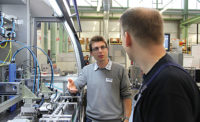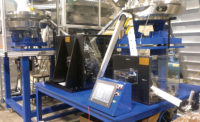Agile Automation System Assembles Automotive Inverters
The flexible system can produce three variants of the product




The automotive industry is at the threshold of a disruption not seen since the Brass Era of the 1900s. Electric vehicles, connectivity, mobility-as-a-service, and autonomous vehicles promise to change the future of transportation in the same way that the “horseless carriage” did a century ago. As cars become less about gears and more about data, the $2 trillion automotive industry is reinventing itself quickly.
Systems integrator Kinemetrix is helping automotive suppliers do just that. Based in Lexington, KY, Kinemetrix has invested heavily in R&D to develop new approaches for assembling electric vehicles and the components that go into them.
Recently, Kinemetrix designed and built an agile, multistation automated assembly system to produce inverter modules for the hybrid variant of one of the largest vehicle programs in the world. An inverter module converts DC voltage from battery storage into multiphase power for driving a traction motor.
The system consists of a series of standardized process modules. Each module is pallet-based, with its own independent transfer conveyor.
“Keeping each module independent is an investment that pays off by maintaining flexibility to reconfigure the line for changes in product design, mix or volume—all three of which occurred between when the project kicked off and when it shipped,” explains Jim Peyton, the founder and president of Kinemetrix.
The system operates in a Class 10,000 clean room and produces an inverter every 120 seconds. Protections against electrostatic discharge (ESD) are included throughout the assembly process.
The inverter is 360 millimeters wide, 250 millimeters long and 120 millimeters tall. The assembly process brings together 24 components using 49 fasteners and a variety of adhesive processes. Approximately 50 precision TIG welds make the high-power electrical connections.
The assembly comprises cast, stamped, formed and machined metals; plastics; printed circuit boards; small wiring harnesses; film and foam insulators. Many of these parts are precise and electrically or mechanically sensitive. Components are fed into assembly modules via magazine trays that nest parts to prevent damage. Magazine trays can be loaded lineside by a single operator. (In the future, Kinemetrix will provide a system of automated guided vehicles to tend the line, or multiple lines, directly from upstream subassembly processes.)
The assembly system is equipped with 22 robots in 17 standardized process modules. Processes include:
- Robotic micro-TIG welding with 3D vision guidance and weld inspection.
- Robotic dispensing of a form-in-place gasket.
- Precision leak testing.
- Robotic pick-and-place and automated screwdriving.
- Potting with a two-component epoxy.
- Manual operation stations for wire harness assembly.
- Convection curing and cooling.
The assembly system has 28 vision-based inspections, 30 code readers, and two Agile3D Copperweld robot guidance and weld inspection systems. The vision inspections use conventional and computational imaging to ensure pre-assembly conditions are within standard. All robotic assembly and screwdriving tasks are vision-guided to minimize tolerance stacking effects. Each automated and manual assembly process is validated before being transferred to the next step.
“The most technically demanding process was the automated micro-TIG welding,” recalls Peyton, who founded Kinemetrix in 1995 after nearly 11 years as a custom equipment designer for Toyota Motor Manufacturing Kentucky Inc. in Georgetown, KY. “We needed to inspect copper power conductors ranging from 1 to 3 millimeters in cross-section, then perform optical inspection on a weld that’s mirror-like and spheroid in shape, in less than 1 second. There are 50 TIG welds that have to be placed within less than 200 microns of joint center. Welds cannot be reworked, so there are 50 opportunities to scrap a very costly assembly every cycle.
“To manage that risk, we conducted early R&D to understand the capabilities and limitations of our Agile3D Copperweld robot guidance and inspection system on this particular application. That effort really shaped how we designed the process and production tooling, and it ensured on-time delivery of the equipment.”
Every component, including fastener and adhesive batches, is tracked via 2D Data Matrix codes. Operators badge-in to manual operations. All data from the assembly process is logged to a database to create a traceable “AssemblyDNA” for each inverter produced.
“When Kinemetrix developed the AssemblyDNA approach, it was primarily for traceability of safety-critical parts. More recently, we’re applying technology from our machine learning research in robotic guidance toward extracting insights from this assembly data,” says Peyton.
The assembly system includes two leak test modules. One for the cooling channels used to remove heat from power electronics. The other to test the dry volume of the final assembly. All screwdriving operations are monitored for torque, angle and axial displacement.
“We helped develop upstream marking and surface finish details to make process validation more robust,” adds Peyton.
The system was built to assemble three product variants. “Before the system was shipped, we helped the customer budget a new variant of the inverter for a specific geographic market. Adapting to the change was straightforward: new assembly pallets, recipe programming, and program launch support,” says Peyton.
Because modules are designed to be interchangeable, new lines can be easily configured to produce similar products, such as electronic control units, transmission control units or power management controllers.
“Having similar hardware, software and user interfaces reduces the training burden on the end-user’s technical staff,” says Peyton. “We’re finding this is much more important now than 20 years ago. Most of our customers’ growing pains come from a difficulty in finding reliable, skilled, technical talent. We’re trying to help with that with thoughtful features, even when it increases initial investment.”
The more complex the process, the more things have to go right to produce defect-free parts, Peyton points out.
“It’s part of Kinemetrix’s ‘agile automation’ approach to design-in high levels of process control automation to remove variation from human sources,” he says. “For example, our AgileDispense cell requires a valid scan of a material data code and team member badge before unlocking the door to load the material bulk tank. Each material tank has its own access door. This prevents a lapse of attention from causing an accidental mixing of two-part adhesive components, damaging the equipment.”
For more information on agile automation, call Kinemetrix at 859-381-9937 or visit www.kinemetrix.com.
Looking for a reprint of this article?
From high-res PDFs to custom plaques, order your copy today!








